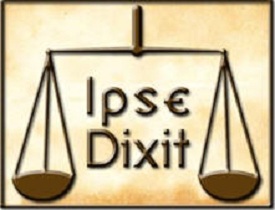
A challenge to an expert opinion based on ipse dixit grounds differs from many Daubert motions in that is does not contest the expert’s qualifications but instead solely attacks the expert’s opinion as conclusory. Since the Supreme Court’s decision in Daubert v. Merrell Dow Pharmaceuticals, Inc., lower federal court rulings reveal you must do more than just spend a lot of money on a well-credentialed expert and then rely on nothing more than a one-dimensional opinion as the basis of your case. To survive summary judgment and prevail at trial, plaintiffs must produce experts that adequately explain how they reached an opinion and how the evidence available in the case scientifically establishes liability. Without a thorough analysis of the evidence, courts have repeatedly stated that they are unwilling to simply take your expert at his word.
Recently, the United States District Court for the Middle District of Florida in Florida Insurance Guaranty Association v. National Presto Industries Inc., 6:2012-cv-00160 (July 19, 2013) granted summary judgment in a products liability case where the expert was found to be qualified but his opinion amounted to nothing more that ipse dixit (Latin for “he himself said it”). The case involved a fire that originated near or within a Presto deep fryer. Although the plaintiff’s expert performed a valid scientific test on an exemplar deep fryer and offered a scientific opinion that the fryer at issue in the case must have failed as a result of the same conditions which created a fire in the exemplar, the expert did not provide any opinions about (or testing on) the bimetallic element on the subject fryer. The court stated:
- [Plaintiff’s expert] nevertheless concludes that [the fryer] must have failed, but when pressed in deposition, he was unable to articulate any basis for this conclusion.
- As such, his testimony amounts to nothing more than inadmissible ipse dixit, as the only connection between the conclusion and the existing data is the expert’s own assertions.
The court then rejected plaintiff’s additional arguments and attempts to cite other evidence. In an effort to overcome summary judgment, plaintiff pointed to the fact “(1) that there is evidence the Fryer was low on oil when the fire started–and the manual lacked sufficient warnings of the attendant dangers of low-oil levels, (2) the power cord became hot during use, and (3) that the Fryer was plugged-in at the time of the fire.”
Similarly, the United States District Court for the Southern District of New York in 405 Condo Associate LLC v. Greenwich Insurance Co. 2012 WL 6700225 (S.D.N.Y. December 26, 2012) granted the defendant insurance company’s motion to bar expert testimony on the basis that it was nothing more than ipse dixit. The case involved an issue of whether the damage to the subject property was caused by wind (and therefore covered by the insurance policy) or by rain (therefore not covered by insurance).
In 405 Condo, the defendant did not challenge the plaintiff expert’s qualifications. Instead, the defendant prevailed on its motion by challenging the reliability of plaintiff’s expert testimony. Although the expert opined “within a reasonable degree of engineering certainty that the roof and flashing were first damaged by wind, and that the water penetration and damage were subsequent to the wind damage,” the court held that the expert’s opinion failed to meet the reliability requirement of Rule 702. The expert based his opinion on a weather report taken at JFK airport — thirteen miles away from subject property and found that the elevated wind speeds resulted in damage to the roof flashing, allowing rainwater to enter the building.
The court found that plaintiff’s expert opinion was inadmissible because the expert report:
does not mention the type of material used in the flashing or attempt to approximate the wind speeds necessary to cause the flashing to peel back. This renders [the expert’s] testimony speculative. Second, [the plaintiff’s expert report] contains no methodology for differentiating wind damage caused by Hurricane Irene from prior damage or rain damage alone. Third, that [plaintiff’s expert] did not examine the roof in person until May 31, 2012 — eight months after the damage allegedly occurred and after repairs had been completed — calls into doubt the reliability of his testimony given the absence of a clear methodology or relevant data.
The Southern District of New York concluded by stating that there is “simply too great an analytical gap between the data and the opinion proffered.”
Both of these recent federal opinions are examples of courts’ growing unwillingness to take an expert at his word, no matter how overwhelming the independent evidence may be or how well-credentialed the expert. Tests on exemplars and the use of other analytics may be useful in establishing liability and convincing a jury to rule in your favor, but they will likely not be enough to carry you past dispositive motions. Experts must examine the evidence in the case and draw conclusions based on that evidence.



